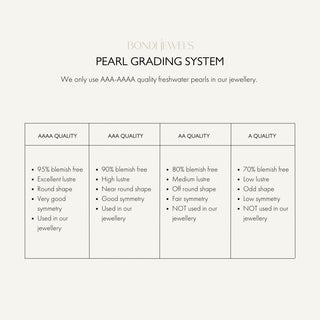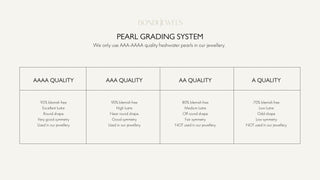OUR PEARLS
At BONDI JEWELS, we use only the finest quality AAA-AAAA grade genuine freshwater pearls. We handpick each pearl that goes into our jewellery from local Australian suppliers which allows us to obtain an extremely high level of quality control.
We use a variety of different types of AAA-AAAA grade pearls in our jewellery including baroque, potato, keshi and seed pearls. Each have their own characteristics, shapes and appearance and are revered for different reasons.
When it comes to selecting pearls for our jewellery we look for a number of quality indicators in our pearls. These include lustre, shape, colour, surface blemishing, size and symmetry.


PEARL QUALITY INDICATORS
Lustre
A pearl's lustre refers to the amount of light reflection on a pearl surface and is the most important factor when selecting pearls. Pearls with a high lustre grade are brighter and shinier with an almost mirror like surface, as opposed to pearls with a low lustre grade which can appear dull and chalky.
Shape
Generally speaking, the more round and symmetrical a pearl the more rare and prized it will be. However, Baroque pearls have increased in demand over the last few years for their unique and organic shape.
Colour
Pearls come in a variety of colours including, white, cream, ivory, pink, peach, gold and black (peacock). The most popular colour of pearl is white, cream or ivory, however certain colours such as black Tahitian pearls are revered for their iridescent colouring and attract a high price point.
Surface Blemishing
Pearls without blemishes or inclusions such as scratches, wrinkles and chalky spots are much more valuable than those with lots of blemishes. Pearls take on a personality of their own but ensuring our pearls are free from as many blemishes as possible is a priority.
Size
The larger the pearl (above 10mm) or the smaller the pearl (below 3mm) the more rare they are and attract a higher price point. The pearls used in our Fine Pearl Necklace are as small as 2.5mm which are small, seed like pearls and can be difficult to source.
Symmetry
The symmetry of a pearl refers to the size between each pearl on a strand or pair of earrings. When matching pearls for a pair of earrings, it's most important to pay attention to each pearls symmetry to find the best match.
NATURAL VS CULTURED PEARLS
Naturally occurring pearls are very rare and attract an extremely high price tag which is why over 95% of pearls today are cultured or farmed.
Culturing pearls, is a long and delicate process whereby a bead nucleus is inserted into an oyster forming a pearl over a period of roughly 6-12 months. Over time, the oyster secretes various layers of aragonite and conchiolin (a substance that also makes up their shell) as a protective mechanism against the foreign object. The resulting product is a pearl that is then carefully extracted from inside the oyster.
Each pearl is unique which is what makes them so prized and valuable, however, there are various quality indicators to consider when selecting pearls for our jewellery. These include lustre, shape, colour, surface blemishing, size and symmetry.
PEARL TYPES WE USE
Baroque pearls
"Baroque" pearls meaning "ornate detail" are our most popular pearls loved by many for their large, organic shape. Each baroque pearl is 100% unique in shape and are distinguished by their striking appearance.
Potato pearls
Known for their oval, "potato like" shape. These types of pearls are the most common pearl we use in our jewellery. Potato pearls are revered for their spectacular elongated shape and consistency from pearl to pearl.
Keshi pearls
Keshi pearls are our second most common pearl used in our jewellery and are known for their asymmetrical, organic shape. Keshi pearls are small non-nucleated pearls which simply means the pearl formed when a bead nucleus (in cultivated pearl farming) was rejected inside the oyster.
Seed pearls
Seed pearls are our most popular type of pearl, revered for their delicate, tiny shape and size. Similar to potato pearls, seed pearls are oval or round in shape and feature in many of our styles. Often difficult to find and source, seed pearls are more rare and attract a higher price point.

